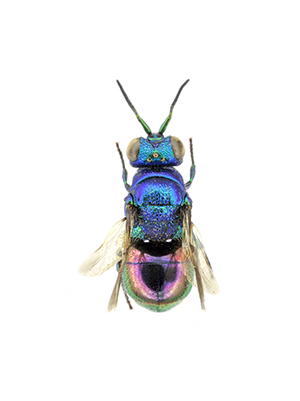Last updated on November 28th, 2023
 From: Kimsey L.S. & Bohart R.M., 1990 (1991) – The chrysidid wasps of the world. Oxford University Press, ix-652 pp.
From: Kimsey L.S. & Bohart R.M., 1990 (1991) – The chrysidid wasps of the world. Oxford University Press, ix-652 pp.
Synonymy
Pseudomalus Ashmead 1902:229. Type: Omalus semicircularis Aaron 1885:215. Orig. desig. and monobasic.
Generic diagnosis
Scapal basin usually deep and smooth, asetose; malar space less than 1 MOD and bisected horizontally by genal carina; head generally lenticular, with carinate post-ocular edge; pronotum deeply concave laterally; scutum with small, scattered punctures, except large dense ones clumped posteriorly between notauli; mesopleuron angulate, with juncture of omaulus, verticaulus, and scrobal carina strongly projecting, scrobal sulcus oblique; scutellum with anterior margin unmodified; metanotum broadly rounded; fore wing medial cell asetose, medial vein strongly arched and arising before cu-a, stigma short, broad and apically rounded; fore femur carinate ventrally and often subapically broadened particularly in females; tarsal claws with 3-5 subsidiary teeth; T-I—III strongly convex; T-III lateral margin straight or sinuate, usually deeply notched apicomedially, without transparent apical rim; genital capsule.
Hosts
These wasps are nest parasites of the sphecid subfamily Pemphredoninae. Because Pseudomalus females have never been observed at the nest entrances of their hosts, the suggestion is that Pseudomalus species place their eggs on the body of aphids (Homoptera) before they are collected by Pemphredoninae (Veenendaal, 2011).
Distribution
Pseudomalus occurs in the Holarctic Region, with a disproportionately large number from southern USSR.
Discussion
Pseudomalus is the largest of the genera split from Omalus in the broad sense, with 42 species. The most distinctive feature of this genus is the pattern of scutal punctation, with the punctures clumped posteriorly between the notauli. Unfortunately, this area is often obliterated when the specimen is pinned. Additional diagnostic features are the malar space horizontally bisected by the genal carina, scutellar anterior margin unmodified, mesopleuron strongly projecting laterally at the juncture of the omaulus and scrobal carina and verticaulus, and T-III usually with a deep apicomedial notch.
Colour and differences in sculpturing are the characters most commonly used to distinguish species. The shape of the apical margin and notch of T-III are particularly useful. Most species have the thorax and abdomen concolorous. However, some Palearctic ones, including auratus, hirtus, and bogdanovi, have the thorax purple, blue, or green, and the terga bright brassy or coppery.
This genus needs extensive revision. Species distinctions are obscure in a number of instances and badly need re-examination.
As with the other genera split from Omalus, the sexes are difficult to separate without exserting the genitalia.
European species
- Pseudomalus abdominalis (Buysson, 1887)
- Pseudomalus auratus (Linnaeus, 1758)
- Pseudomalus bergi (Semenov, 1932)
- Pseudomalus borodini (Semenov, 1932)
- Pseudomalus meridianus Strumia, 1996
- Pseudomalus pusillus (Fabricius, 1804)
- Pseudomalus pusillus bulgariensis (Linsenmaier, 1959)
- Pseudomalus pusillus semicupreus (Linsenmaier, 1959)
- Pseudomalus ruthenus (Semenov, 1932)
- Pseudomalus triangulifer (Abeille, 1877)
- Pseudomalus violaceus (Scopoli, 1763)
Copyright, Authorship, and Ownership statements
All text and images of this page are copyright ©️ Chrysis.net unless otherwise stated - please see individual cases for authorship and copyright details. The specimens pictured are from the authors' or other collaborators' personal collections and from the collections of various museums. Unless otherwise specified, the whole content of this web site is for personal, non-commercial, scientific, and educational purposes given proper accreditation to the page from which they were derived are provided, and under Chrysis.net Terms and Conditions.
For citation purposes
Agnoli G.L. & Rosa P. (2025) Genus Pseudomalus Ashmead, 1902, in: Chrysis.net website. Interim version 22 April 2025, URL: https://www.chrysis.net/database/genus-pseudomalus/.




